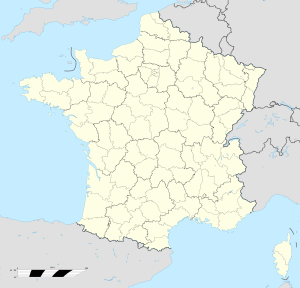- Ouvrage Monte Grosso
-
Ouvrage Monte Grosso Part of Maginot Line, Alpine Line Southeast France Coordinates 43°54′49″N 7°27′47″E / 43.9136°N 7.46309°ECoordinates: 43°54′49″N 7°27′47″E / 43.9136°N 7.46309°E Built by CORF Construction
materialsConcrete, steel, rock excavation In use Abandoned Controlled by France Battles/wars Italian invasion of France, Operation Dragoon Ouvrage Monte Grosso Type of work: Large artillery work (Gros ouvrage) sector
└─sub-sectorFortified Sector of the Maritime Alps
└─Sospel, Quartier BrouisWork number: EO 2 Regiment: 85th BAF, 158th RAP Number of blocks: 7 Strength: 10 officers, 363 men Ouvrage Monte Grosso is a work (gros ouvrage) of the Maginot Line's Alpine extension, the Alpine Line, also known as the Little Maginot Line. The ouvrage consists of one entry block, four artillery blocks and two observation blocks facing Italy. It was the largest ouvrage in the Alps [1] It is part of the fortifications surrounding Sospel, which protect the approaches to Nice from the north.
Contents
Description
Monte Grosso, like L'Agaisen to the southeast, features gun turrets on a commanding height, at 967 meters. Monte Grosso possesses two turrets, one of 75mm and a unique 135mm turret, both retractable. Monte Grosso was built between November 1931 and June 1935, by a contractor named Borie. The cost was 40.4 million francs, of which 4.6 million francs were for the access road.[2]
- Block 1 (entry): one machine gun cloche, one grenade launcher cloche and three machine gun embrasures.[3]
- Block 2 (artillery): one machine gun cloche, one twin machine gun embrasure, two 75mm/29cal gun embrasures and two machine gun embrasures.[4]
- Block 3 (mortar): one machine gun cloche and four 81mm mortar embrasures.[5]
- Block 4 (artillery): one machine gun cloche and one twin 75mm/33cal gun turret.[6]
- Block 5 (artillery): one grenade launcher cloche and one twin 135mm howitzer turret.[7]
- Block 6 (infantry): one observation cloche, one machine gun cloche and two twin machine gun embrasures.[8]
- Block 7 (infantry): one observation cloche, one machine gun cloche and twin machine gun embrasure.[9]
An additional block near the entrance with a GFM cloche and two 75mm mortars was never built. The galleries extend along the length of the Monte Grosso ridge.[10]
History
On 15 June 1940, as Italian troops advanced into France, Monte Grosso fired on Italian mortar positions. On the 20th, it received fire from Italian 149mm guns, with a hit on its 75mm turret. The gun remained in operation[1]
See also
References
- ^ a b Kaufmann 2006, p. 17
- ^ Mary, Tome 4, p. 29
- ^ Puelinckx, Jean; Aublet, Jean-Louis & Mainguin, Sylvie (2010). "Monte Grosso (go du) Bloc 1" (in French). Index de la Ligne Maginot. fortiff.be. http://www.fortiff.be/maginot/index.php?p=5897. Retrieved 26 January 2010.
- ^ Puelinckx, Jean; et al (2010). "Monte Grosso (go du) Bloc 3" (in French). Index de la Ligne Maginot. fortiff.be. http://www.fortiff.be/maginot/index.php?p=5898. Retrieved 26 January 2010.
- ^ Puelinckx, Jean; et al (2010). "Monte Grosso (go du) Bloc 4" (in French). Index de la Ligne Maginot. fortiff.be. http://www.fortiff.be/maginot/index.php?p=5899. Retrieved 26 January 2010.
- ^ Puelinckx, Jean; et al (2010). "Monte Grosso (go du) Bloc 5" (in French). Index de la Ligne Maginot. fortiff.be. http://www.fortiff.be/maginot/index.php?p=5900. Retrieved 26 January 2010.
- ^ Puelinckx, Jean; et al (2010). "Monte Grosso (go du) Bloc 6" (in French). Index de la Ligne Maginot. fortiff.be. http://www.fortiff.be/maginot/index.php?p=5900. Retrieved 26 January 2010.
- ^ Puelinckx, Jean; et al (2010). "Monte Grosso (go du) Bloc 7" (in French). Index de la Ligne Maginot. fortiff.be. http://www.fortiff.be/maginot/index.php?p=5902. Retrieved 26 January 2010.
- ^ Puelinckx, Jean; et al (2010). "Monte Grosso (go du) Bloc 8" (in French). Index de la Ligne Maginot. fortiff.be. http://www.fortiff.be/maginot/index.php?p=5902. Retrieved 26 January 2010.
- ^ Mary, Tome 5, p. 56–57
Bibliography
- Allcorn, William. The Maginot Line 1928-45. Oxford: Osprey Publishing, 2003. ISBN 1-84176-646-1
- Kaufmann, J.E. and Kaufmann, H.W. Fortress France: The Maginot Line and French Defenses in World War II, Stackpole Books, 2006. ISBN 0-275-98345-5
- Kaufmann, J.E. , Kaufmann, H.W., Jancovič-Potočnik, A. and Lang, P. The Maginot Line: History and Guide, Pen and Sword, 2011. ISBN 978-1-84884-068-3
- Mary, Jean-Yves; Hohnadel, Alain; Sicard, Jacques. Hommes et Ouvrages de la Ligne Maginot, Tome 1. Paris, Histoire & Collections, 2001. ISBN 2-908182-88-2 (French)
- Mary, Jean-Yves; Hohnadel, Alain; Sicard, Jacques. Hommes et Ouvrages de la Ligne Maginot, Tome 4 - La fortification alpine. Paris, Histoire & Collections, 2009. ISBN 978-2-915239-46-1 (French)
- Mary, Jean-Yves; Hohnadel, Alain; Sicard, Jacques. Hommes et Ouvrages de la Ligne Maginot, Tome 5. Paris, Histoire & Collections, 2009. ISBN 978-2-35250-127-5 (French)
External links
- Monte Grosso (gros ouvrage) at fortiff.be (French)
Fortified Sector of Savoy (La Tarentaise) Fortified Sector of Savoy (La Maurienne) Fortified Sector of the Dauphiné Fortified Sector of the Maritime Alps Col de Crous • Col de la Valette • Rimplas • Fressinéa • Valdeblore • La Séréna • Col du Caire Gros • Col du Fort • Gordolon • Flaut • Baisse de Saint-Véran • Plan Caval • La Béole • Col d'Agnon • La Déa • Col de Brouis • Monte Grosso • Champ de Tir • L'Agaisen • Saint-Roch • Barbonnet • Castillon • Col des Banquettes • Saint-Agnès • Col de Garde • Mont Agel • Roquebrune • Croupe du Réservoir • Cap MartinMaginot Line Corsica 'Categories:- Fortified Sector of the Maritime Alps
- Maginot Line
- Alpine Line
- Fortification stubs
Wikimedia Foundation. 2010.

